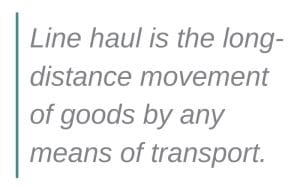
Line haul is the long-distance transportation of goods between distribution centers or hubs, serving as the backbone of the entire supply chain. Think of it as the critical middle leg in a relay race that sets the pace and tone for the final sprint, commonly known as the “last mile,” which ends at the customer’s doorstep. But it’s not just a transitional phase; it’s a pivotal stage that can make or break your overall delivery performance.
Optimizing your line haul operations is important; by focusing on efficiency measures like route planning, vehicle maintenance, and real-time data exchange, you’re not only streamlining this specific stage but also setting the groundwork for more efficient, cost-effective, and customer-friendly last-mile delivery. Every minute and mile counts in today’s highly competitive landscape. Fine-tuning your line haul processes is a strategic move that pays dividends across your entire logistics operation.
The Line Haul Process
What is the Line Haul Stage in the Supply Chain?

Line haul is the unsung hero of the logistics world, often overshadowed by the hype around last-mile delivery. Yet, this critical intermediary phase sets the stage for a successful final mile. Think of line haul as the long-haul flight in your journey—covering vast distances, often crossing state lines or international borders. It’s the essential leg that ensures your goods reach local distribution centers, primed and ready for the last-mile sprint to the customer’s doorstep.
Key Components and Considerations for Line-Haul
Route Planning: The Roadmap to Efficiency
Route planning isn’t just about drawing a line from Point A to Point B. It’s actually a complex algorithm that considers multiple variables like traffic, weather, and road conditions. Efficient routes are the cornerstone of a successful line haul operation, saving time and fuel. Today’s advanced route optimization software can provide real-time analytics, allowing you to make dynamic adjustments that can shave off significant transit time.
Vehicle Maintenance
A well-maintained fleet is like a finely tuned orchestra—every component working in harmony to produce a flawless performance. Regular maintenance checks, timely repairs, and proactive replacements are non-negotiables in line haul operations. Any downtime can trigger a cascade of delays that ripple down to the last-mile delivery, affecting customer satisfaction and operational costs. Vehicle maintenance becomes an investment in long-term efficiency instead of just an expense.
Load Optimization: The Science of Packing
Load optimization is an intricate dance of geometry and physics. It’s about filling up a truck in a way that maximizes space without compromising on the safety or integrity of the goods. This involves a deep understanding of the cargo—its dimensions, weight, and how different items interact during transit. Proper load optimization can drastically reduce the number of trips needed, thereby cutting down on both costs and carbon footprint. Not only that but planning your load ahead of time can shave crucial time off your order processing and deliveries.

Setting the Stage for Efficient Last-Mile Deliveries
The line haul process is like the opening act of a concert. It sets the tone and builds anticipation for the headliner, which in this case, is the last-mile delivery. A well-executed line haul ensures that goods arrive at local distribution centers on time and in optimal condition. This smooth transition is crucial for maintaining the efficiency and reliability of the last leg of the journey, directly impacting customer satisfaction.
By meticulously planning routes, maintaining vehicles, and optimizing loads, logistics managers can create a line haul process that is a masterpiece of efficiency. It’s this attention to detail in the line haul stage that makes the promise of timely last-mile deliveries not just a possibility but a guarantee.
The Impact of Line Haul on Efficiency
Benefits of Streamlined Line Haul Processes
The efficiency of line haul operations doesn’t just affect that specific stage of the supply chain. It has a ripple effect that extends all the way to the last mile and ultimately, the customer. Let’s look at the key benefits that a streamlined line haul process brings to the table.
Reduced Transit Times: The Speed Factor
Time is of the essence in the logistics industry, and nowhere is this more evident than in line haul operations. A streamlined line haul process can significantly reduce transit times, which has a direct impact on last-mile deliveries. Imagine your goods are like a relay race baton; the faster they move in the line haul stage, the quicker they reach the last-mile runner. This speed is especially crucial in today’s world of same-day and next-day delivery expectations. Reduced transit times mean you can promise—and deliver—faster shipments, giving you a competitive edge in the market.
Lower Operational Costs
Efficiency is a critical metric that directly affects your bottom line. A well-optimized line haul process can lead to substantial savings in fuel and labor costs. For instance, efficient route planning can reduce the distance traveled, thereby lowering fuel consumption. Similarly, quicker transit times mean drivers complete their routes faster, reducing labor hours and associated costs. These savings might seem incremental on a single trip, but they add up over time, leading to a significant reduction in operational expenses.
Improved Customer Satisfaction
It’s the age of instant gratification and customer expectations are sky-high. A streamlined line haul process ensures that goods arrive at local distribution centers on time, setting the stage for timely last-mile deliveries. And we all know that on-time deliveries are a surefire way to make customers happy. Satisfied customers are not just repeat buyers. They’re also your brand ambassadors, spreading positive word-of-mouth that can be invaluable for your business reputation.
The Synergy of Efficiency
The perks of a well-run line haul process all work together, boosting the overall performance of your entire operation. Reduced transit times lead to lower operational costs, which in turn contribute to improved customer satisfaction. It’s a virtuous cycle that feeds into itself, creating a loop of continuous improvement.
At the end of the day, the efficiency of your line haul operations is a key performance indicator that has far-reaching implications for your entire supply chain, right down to the customer experience. By focusing on streamlining this critical stage, you’re not just optimizing one part of your business; you’re elevating your entire operation to new heights of efficiency and customer satisfaction.
Dive deeper into the world of last-mile logistics by downloading our latest white papers for free!
ERP Meets Last-Mile Delivery
Discover how ERP and last-mile delivery software integration can unlock efficiencies, enhance customer satisfaction, and boost profits.
Top 10 Features to Look for in a Last-Mile TMS Software
In this white paper, we dive into the top 10 features you should be looking for when selecting a last-mile TMS solution for your operations.
Synchronizing Line Haul and the Last Mile
How They Work Together
Line haul and last-mile operations are like the yin and yang of logistics—two seemingly opposite yet complementary stages that need to harmonize for the entire delivery process to be successful. While line haul focuses on the long-distance transportation of goods between distribution centers, the last mile is all about getting those goods from the local distribution center to the customer’s doorstep. Each stage has its own set of challenges and requirements, but they’re intrinsically connected. A delay or inefficiency in the line haul stage can have a cascading effect on last-mile deliveries, and vice versa. Therefore, it’s crucial for these two operations to be in sync, working together like gears in a well-oiled machine.
The Importance of Data Exchanges and Communication
Data is the lifeblood of any operation, and logistics is no exception. Real-time data sharing between line haul and last-mile teams is something you have to have. This data exchange serves as the nervous system of your logistics operation, transmitting vital information that allows for dynamic adjustments to routes, schedules, and even load configurations.
Why Real-Time Data Matters
Imagine a scenario where a line haul truck is delayed due to unforeseen road conditions. Real-time data sharing would allow the last-mile team to adjust their schedules proactively, perhaps even rerouting other vehicles to cover for the delay. This level of dynamic adjustment is only possible when there is seamless communication between the two stages.
Types of Data to Share
The types of data that should be shared can range from basic information like estimated times of arrival (ETAs) to more complex data like load dimensions, traffic conditions, and even driver performance metrics. The more comprehensive the data, the better equipped both teams are to make informed decisions.
Best Practices for Synchronizing Line Haul and Last Mile
- Integrated Software Platforms: Utilize software solutions that offer integrated dashboards for both line haul and last-mile operations.
- Regular Briefings: Conduct regular briefings between teams to discuss challenges, updates, and strategies for improvement.
- Automated Alerts: Implement automated alert systems for critical milestones or potential issues, ensuring immediate attention and action.
- Performance Metrics: Establish key performance indicators (KPIs) that are aligned across both operations, facilitating a unified approach to performance optimization.
The Payoff: Logistics Efficiency
When line haul and last-mile operations are perfectly synchronized, the result is a symphony of efficiency that resonates throughout the entire supply chain. It’s not just about avoiding delays or cutting costs; it’s about creating a seamless, frictionless experience for the customer. In a competitive landscape where customer satisfaction is paramount, the ability to deliver on time, every time, can be your ultimate differentiator.
Best Practices and Optimization Tips: The Roadmap to Logistics Excellence
In logistics, where line haul and last-mile operations must work in harmony, implementing best practices and optimization strategies isn’t just advisable—it’s essential. Here’s a focused guide on how to elevate your logistics game.
Use Advanced Route Optimization Software

Relying on manual methods for route planning is similar to navigating a ship without a compass. Advanced route optimization software uses algorithms and real-time data to determine the most efficient routes, taking into account variables like traffic, weather, and road conditions. This saves time and reduces fuel usage, contributing to both operational efficiency and sustainability goals.
Regularly Review Performance Metrics
What gets measured gets managed. Regularly reviewing performance metrics allows you to identify bottlenecks, inefficiencies, and areas for improvement in both line haul and last-mile operations. KPIs like delivery times, fuel efficiency, and customer satisfaction rates offer valuable insights into the health of your logistics operations. These metrics serve as a pulse check, helping you make data-driven decisions that can significantly improve performance.
Foster Open Communication Between Teams
While technology and data are vital, never underestimate the power of human communication. Open, transparent communication between line haul and last-mile teams is vital for resolving issues, sharing insights, and fostering a culture of continuous improvement. Regular team meetings, real-time messaging platforms, and even informal catch-ups can go a long way in breaking down silos and encouraging collaborative problem-solving.
Bonus Tip: Continuous Training and Skill Development
Continuous training for your team is an absolute must. Whether it’s new software tools, updated regulations, or emerging best practices, keeping your team up-to-date ensures you’re always operating at peak efficiency.
By implementing these best practices and optimization tips, you’re not just putting out fires or making incremental improvements. You’re building a robust, resilient logistics operation that’s equipped to adapt, evolve, and excel in an ever-changing landscape. It’s about taking a proactive approach to problem-solving and performance enhancement, setting the stage for long-term success.
The Last Mile Begins with the First Step in Line Haul
Optimizing line haul operations is a strategic move that has a ripple effect on the entire supply chain, most notably on last-mile deliveries. By zeroing in on key components such as meticulous route planning, and real-time data exchange, and fostering a culture of open communication between teams, logistics managers can elevate their operations from good to great. These aren’t just tweaks or minor adjustments; they’re transformative changes that can lead to significant improvements in efficiency, cost savings, and ultimately, customer satisfaction.
For those looking to take their last-mile delivery performance to the next level, consider leveraging advanced solutions tailored to your specific needs. Elite EXTRA offers a range of cutting-edge tools designed to optimize every facet of your logistics operations, from line haul to the last mile. The journey to exceptional last-mile delivery performance begins with the first step in optimizing your line haul operations. It’s a holistic approach that promises not just short-term gains but long-term success.
Sources
https://www.logisticsmgmt.com /article/driving_the_risk_out_of_line_haul_ fleet_management_with_aiot_technologies
https://truckstop.com /blog/line-haul-transportation/
https://www.automationfactory.ai /realtime-data-anaytics-importance
https://www.insiderintelligence.com /insights/last-mile-delivery-shipping-explained/









